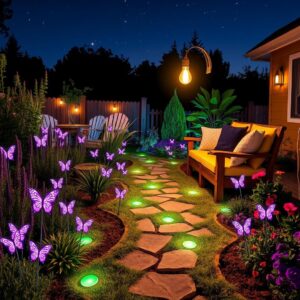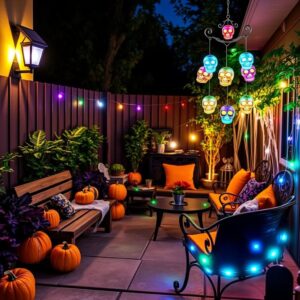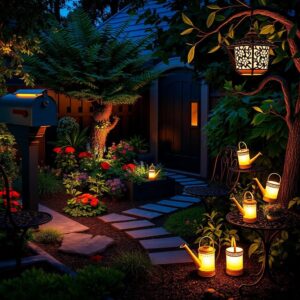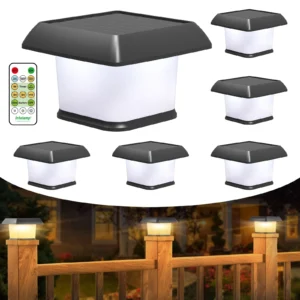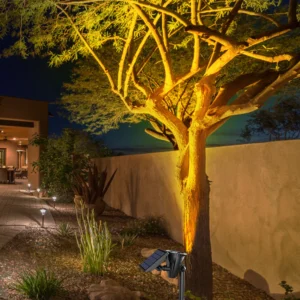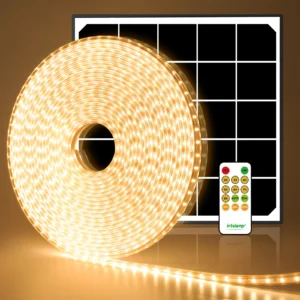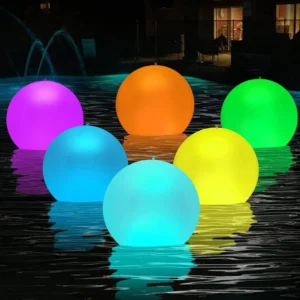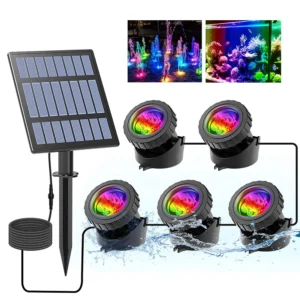Solar lights are an excellent choice for illuminating your property while being cost-effective and environmentally friendly. They enhance the aesthetics of your outdoor spaces and provide practical lighting solutions. However, many homeowners wonder: how long do solar lights last? This article will explore the average lifespan of solar lights, factors influencing their longevity, and tips for proper maintenance to ensure they shine brightly for years to come.
Lifespan of Solar Inground Lights
Understanding the lifespan of solar inground lights is crucial for homeowners seeking reliable outdoor lighting solutions. On average, these lights last around two years, but several factors can influence their longevity, including the quality of components, environmental conditions, and usage patterns.
Battery Performance: The heart of any solar light is its battery, which stores energy during the day to power the light at night. Most solar lights use rechargeable batteries, such as nickel-metal hydride (NiMH) or lithium polymer. Over time, batteries can lose their ability to hold a charge, typically after about two years of regular use. High-quality batteries tend to last longer, so opting for solar lights equipped with superior batteries can significantly extend their operational lifespan.
Material Quality: The materials used in solar inground lights also play a vital role in determining their longevity. Lights made from durable materials like stainless steel or tempered glass can withstand environmental stress better than those made from plastic. Plastic components may become brittle and break under harsh weather conditions, leading to reduced functionality. Therefore, investing in lights constructed from high-quality materials can help ensure that they remain effective and visually appealing over time.
Environmental Factors: The environment in which solar lights are installed can greatly impact their lifespan. Areas with frequent cloud cover, heavy rain, or extreme temperatures can shorten the life of solar lights. Adequate sunlight is essential for maintaining battery performance, so installing lights in well-lit areas that receive direct sunlight during the day will help prolong their lifespan. Additionally, exposure to moisture or flooding can damage internal components, so ensure proper drainage in your installation area.
Installation Method: The way solar lights are installed can also affect their durability. Properly securing lights—whether by using stakes, screws, or other mounting methods—can help them withstand windy conditions and prevent physical damage. If lights are not installed securely, they may be prone to tipping over or being damaged by falling debris.
Usage Patterns: The frequency of use influences how long solar lights last. Lights that are used regularly, such as those in high-traffic areas, may wear out faster than those in less frequented spaces. However, using lights consistently can sometimes help maintain battery health by ensuring regular charging cycles. Consider adjusting your usage patterns or selecting lights with longer-lasting components if you require more frequent illumination.
Maintenance Practices: Regular maintenance can significantly extend the lifespan of solar inground lights. Cleaning solar panels to remove dirt and debris ensures maximum sunlight absorption, enhancing battery charging efficiency. Additionally, performing monthly checks for damage, loose connections, and battery performance can help catch potential issues before they lead to failure.
Material Quality
The material quality of solar inground lights plays a critical role in determining their durability, performance, and overall lifespan. When selecting solar lights for your outdoor space, understanding the different materials available can help you make informed decisions that ensure long-lasting illumination. Here’s a detailed look at various materials commonly used in solar lights and their implications:
Plastic:
- Cost-Effectiveness: Plastic solar lights are typically the most affordable option, making them popular for budget-conscious consumers.
- Durability Issues: However, plastic is less durable compared to other materials. It can become brittle over time, especially when exposed to harsh UV rays or extreme weather conditions. This brittleness increases the likelihood of cracks and breakage, reducing the lifespan of the lights.
- Design Versatility: Despite their drawbacks, plastic lights often come in a variety of designs and colors, appealing to those looking for decorative options for their gardens or pathways.
Metal:
- Strength and Durability: Metal solar lights, particularly those made from stainless steel or aluminum, offer superior strength and durability. These materials can withstand impact, weather changes, and other environmental stresses, making them an excellent choice for long-term use.
- Corrosion Resistance: Stainless steel is resistant to rust and corrosion, which is particularly beneficial in humid or coastal environments where moisture can damage other materials.
- Aesthetic Appeal: Metal lights often have a sleek, modern look that can enhance the overall design of your outdoor space, adding both functionality and style.
Glass:
- High-End Aesthetic: Glass solar lights tend to have a more elegant appearance compared to plastic or metal options. They can create a more upscale look in gardens, patios, and walkways.
- Durability: While glass can be more fragile than metal, many high-quality glass solar lights are designed to withstand outdoor conditions, often featuring tempered or reinforced glass to resist shattering.
- Light Diffusion: Glass materials can provide better light diffusion, resulting in a softer, more inviting glow compared to some plastic options, enhancing the ambiance of outdoor spaces.
Composite Materials:
- Innovation in Design: Some solar lights utilize composite materials that combine the advantages of different substances. For example, a combination of metal and plastic can provide the aesthetic benefits of metal while maintaining lightweight properties.
- Environmental Resistance: Composites are often engineered to be resistant to UV rays, moisture, and temperature fluctuations, making them suitable for various climates.
Solar Panel Quality:
- Panel Material: Beyond the housing materials, the quality of the solar panel itself is essential. Panels made from monocrystalline silicon tend to be more efficient and durable compared to polycrystalline panels, providing better energy conversion and longer life.
- Coatings and Protection: Look for solar panels with protective coatings to guard against scratches, dust, and moisture. This protection can enhance performance and longevity.
Battery Compartment:
- Material Considerations: The materials used in the battery compartment can also impact durability. A well-sealed compartment made from robust materials can prevent water ingress and protect the battery from moisture damage.
- Insulation: Proper insulation and sealing can enhance the lifespan of the internal components, ensuring they function optimally regardless of outdoor conditions.
.
Battery Types and Longevity
The type of battery used in solar inground lights is crucial for their performance, longevity, and overall efficiency. Understanding the different battery options available, their characteristics, and how they impact the lifespan of solar lights can help you make informed decisions. Here’s a comprehensive look at the most common battery types used in solar lighting, along with factors influencing their longevity.
Nickel-Metal Hydride (NiMH):
- Common Usage: NiMH batteries are one of the most frequently used battery types in solar lights due to their balanced performance and cost-effectiveness.
- Capacity and Efficiency: These batteries generally have a good energy capacity and can handle numerous charge and discharge cycles, making them suitable for daily use. They are known for their ability to maintain performance even in partially shaded conditions.
- Longevity: NiMH batteries typically last around 2-3 years, depending on usage and charging conditions. Their longevity can be affected by factors such as exposure to extreme temperatures and how often they are fully discharged.
Lithium Polymer (LiPo):
- Advanced Performance: Lithium polymer batteries are increasingly popular in higher-end solar lights due to their superior performance characteristics. They have a higher energy density, meaning they can store more energy in a smaller size.
- Longevity: LiPo batteries can last significantly longer than traditional NiMH batteries, often exceeding 3-5 years with proper care. They are less prone to the memory effect (where batteries lose their maximum energy capacity if not fully discharged before recharging), contributing to their extended lifespan.
- Temperature Resistance: These batteries perform well in a wider range of temperatures, making them ideal for varying climates.
Nickel-Cadmium (NiCd):
- Older Technology: NiCd batteries are less commonly used in modern solar lights due to environmental concerns and the availability of better alternatives. They have a reputation for being less efficient and having a lower energy capacity than NiMH and LiPo batteries.
- Longevity: NiCd batteries typically last about 1-3 years but may require more frequent replacement due to their susceptibility to the memory effect. They can also lose their charge more quickly if not fully discharged regularly.
- Environmental Concerns: Cadmium is a toxic heavy metal, which raises concerns regarding disposal and environmental impact.
Lead-Acid Batteries:
- Heavy-Duty Applications: While less common in small solar lights, lead-acid batteries are used in larger solar installations, such as solar-powered outdoor lighting systems or backup power applications.
- Longevity: These batteries can last 3-5 years but require more maintenance and have a lower energy density compared to modern battery types. They are also heavier, which may not be suitable for all solar lighting designs.
Battery Capacity and Size:
- Larger Batteries for Longer Life: The size and capacity of the battery directly affect how long solar lights can operate between charges. A larger battery can store more energy, allowing the lights to shine brighter and longer, especially on cloudy days or during winter months when sunlight is limited.
- Typical Ratings: Most solar lights will have battery capacities ranging from 600 mAh to 2,500 mAh. Choosing lights with larger capacity batteries can enhance performance and longevity.
Maintenance and Care:
- Regular Checks: To ensure optimal battery performance, it’s important to regularly check the batteries for any signs of wear, corrosion, or leakage. This is especially true for older batteries, which may need to be replaced periodically.
- Cleaning: Keeping the solar panels clean will help maximize sunlight absorption, ensuring that batteries receive the necessary charge. Dirty panels can lead to inadequate charging, resulting in shorter battery life.
Environmental Impact on Longevity:
- Temperature Sensitivity: Extreme temperatures can adversely affect battery performance. High heat can cause batteries to degrade faster, while cold conditions can limit their ability to hold a charge. Installing solar lights in areas with moderate temperatures can help extend battery life.
- Sunlight Exposure: Consistent and direct sunlight exposure during the day is essential for maximizing battery charging. Areas with excessive shade can significantly reduce battery longevity and overall performance.
Installation and Maintenance Tips
Proper installation and maintenance are vital for ensuring the longevity and optimal performance of solar inground lights. By following best practices during installation and implementing routine maintenance, homeowners can maximize the benefits of their solar lighting systems. Here’s a comprehensive guide on installation and maintenance tips to enhance the lifespan of your solar lights.
Installation Tips
Choose the Right Location:
- Sunlight Exposure: Select a location that receives ample sunlight throughout the day, ideally 6-8 hours of direct sunlight. Avoid areas shaded by trees, buildings, or other structures that could impede solar panel efficiency.
- Even Ground: Ensure the installation site is level and free from obstructions. This helps stabilize the lights and allows for proper drainage, reducing the risk of water damage.
Proper Depth:
- Inground Lights: When installing inground lights, dig a hole deep enough to accommodate the light fixture securely. This ensures stability and prevents the lights from being dislodged by foot traffic or natural elements.
Use Quality Tools:
- Installation Tools: Use appropriate tools for installation, such as a shovel or auger for digging and a level to ensure the lights are properly positioned. Following manufacturer guidelines will help ensure the installation process is smooth.
Follow Manufacturer Instructions:
- Installation Guidelines: Always refer to the manufacturer’s installation instructions for specific guidelines regarding your solar lights. This includes recommendations for spacing, mounting height, and wiring (if applicable).
Test Before Securing:
- Initial Testing: Before permanently securing the lights in place, test them to ensure they function correctly. This step allows for any necessary adjustments to positioning or connections.
Maintenance Tips
Regular Cleaning:
- Solar Panels: Keep the solar panels free from dust, dirt, and debris to maximize sunlight absorption. Clean the panels gently with a soft cloth or sponge and a mild soap solution, ensuring they are dry before reinstallation.
- Light Fixtures: Wipe down the light fixtures regularly to remove any buildup that could block light output or damage the materials.
Check Battery Health:
- Monthly Inspections: Inspect the batteries monthly for signs of corrosion, leakage, or damage. Replace batteries as needed, following the specific guidelines for the type of battery used in your lights.
- Battery Replacement: If you notice a significant drop in performance, it may be time to replace the batteries, typically every 2-5 years depending on the type.
Examine Connections and Wiring:
- Connection Checks: Regularly check the connections and wiring for signs of wear or corrosion. Secure any loose connections to prevent operational issues.
- Weatherproofing: Ensure that any exposed wiring is adequately weatherproofed to protect against moisture and damage from environmental conditions.
Seasonal Maintenance:
- Winter Care: If you live in an area with harsh winters, consider removing and storing your solar lights indoors to prevent damage from freezing temperatures or heavy snow.
- Reinstallation in Spring: Reinstall the lights once the risk of frost has passed, ensuring they are properly cleaned and checked for functionality.
Adjusting Positioning:
- Repositioning for Seasons: Depending on seasonal changes, you may need to adjust the positioning of your solar lights to optimize sunlight exposure, especially in areas with significant foliage growth.
Inspect for Damage:
- Physical Checks: Regularly inspect the fixtures for cracks, rust, or other signs of wear. Promptly replace any damaged components to maintain performance and safety.
- Environmental Factors: Be aware of local wildlife and environmental factors that may affect your solar lights. For example, pests may damage wiring or fixtures, necessitating protective measures.
Light Usage:
- Regular Usage: Use your solar lights regularly to keep the batteries functioning optimally. Lights that are rarely used may experience reduced battery life due to inactivity.
Conclusion
By understanding the factors that influence the lifespan of solar lights and following these maintenance tips, you can enjoy bright and beautiful outdoor lighting for many years. High-quality solar inground lights not only enhance your landscape but also provide a sustainable lighting solution. If you’re interested in learning more about solar lights, check out our other blog posts on solar lighting principles and creative solar light decoration ideas.
Invest in quality, maintain regularly, and enjoy the benefits of your solar lights!


